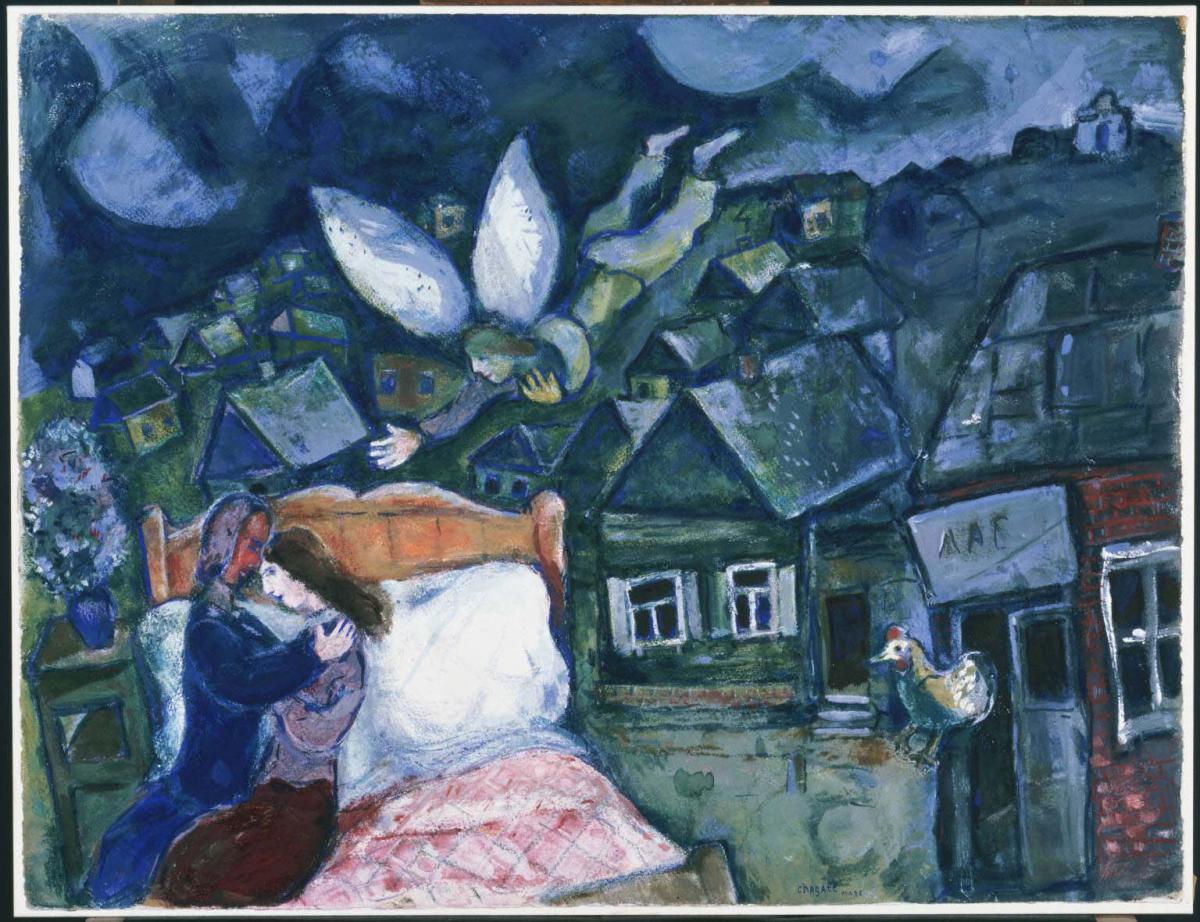The Dream
Marc Chagall ( 1939 )

In The Dream, Marc Chagall explores youthful love and village life through a tapestry of motifs from a multitude of sources and memories: the Old and New Testaments, remembrances of Russia, and his own imagined landscape of a promised land. The suspension of narrative logic harkens back to Russian folkloric and Hasidic culture, as well as to Medieval painting; its compositional principles draw on Byzantine pictorial structure, which informs the use of light, color, and space, and cubist overtones, visible in the repeating geometric forms of the landscape.
The year 1939 was a turbulent one for Chagall, as he and his family were forced to leave Paris and take refuge in the French countryside after the outbreak of World War II. Despite this upheaval, it was a turning point in Chagall’s development, ushering in a new cohesiveness and order—qualities that infuse The Dream with profound harmony. The village theme, usually included as a vignette in this era, has here become the primary motif.
Echoes of Chagall’s biblical studies for earlier illustrations and his extensive travel bear fruit in The Dream. A Palestinian landscape is mingled with motifs from Vitebsk, merging the artist’s vision of the past with a land of future and hope. Folkloric allusions in the setting, the floating rooster, and the hovering angel are overlaid with Venetian color; the expressive forms recall the work of early renaissance masters. Chagall recalls Rembrandt’s painting The Jewish Bride in his depiction of the poignant moment and tender gestures of the lovers. Their mood extends throughout the central landscape, where the angel, in Western dress, proffers a blessing with a gesture of affirmation; the tiny building with a cupola on the hill reinforces this spiritual aura. In the foreground, the interior scene is warm white, and brown tones suggest a separate light source. To the right is an architectural motif often found in Chagall’s work: a narrow house with a sign above the door, recalling his apprenticeship as a sign painter. Though the lettering here is somewhat indistinct, it is possibly the Russian word for “shop.” Alternatively, Alfred Werner has suggested that The Dream is an Annunciation scene and that the house, which has “Laz” above the door, could be a reference to a hospital.
Chagall’s lovers, often portrayed as weightless, ecstatic beings set amid a swirl of saturated colors, usually suggest sensual love. The mood in the present work, however, is more spiritual in its reflection of conjugal love, apparent in the serene harmony between the lovers, an interpretation underscored by the sonorous hues of blue and green.
This new depth of feeling may indicate Chagall’s response to the rapidly deteriorating political situation in Europe and Russia. The Dream, contains echoes of anxiety; while a sense of personal happiness and fulfillment pervades the foreground, a series of dark peaks beyond the village suggest cataclysmic forces that threaten to engulf the scene. The title itself, shared by several works of the late thirties, may suggest a desire to escape the increasing turmoil.
Chagall’s presence in America from the summer of 1941 until 1948, at just the point when he was achieving artistic mastery, furthered his gradual acceptance here. Phillips’s recognition of Chagall’s genius through acquisitions and exhibition in the early 1940s placed him in the vanguard of American collectors; this recognition also coincided with Phillips’s eloquent writings on the threat of war. His Chagall exhibition, the first solo show of the artist’s work in a U.S. museum, opened in the fall of 1942. In the context of political upheaval, Phillips may well have appreciated The Dream’s allusion to the sanctity and security of the individual being threatened by amorphous and malevolent forces.